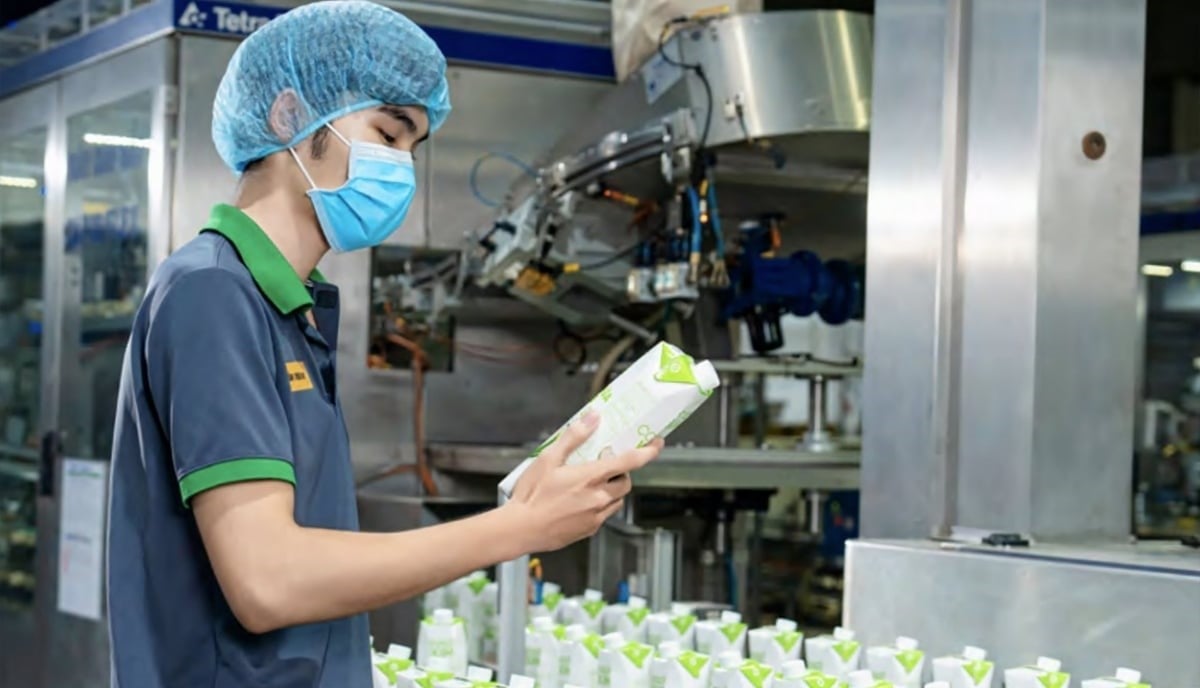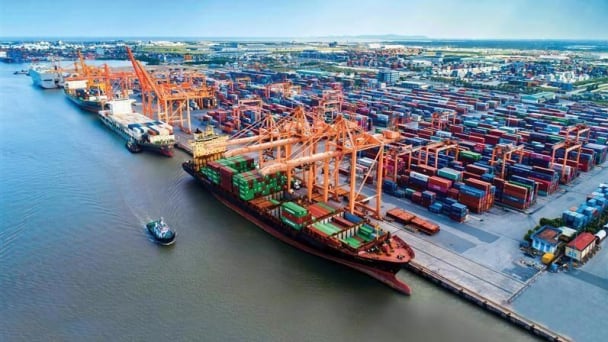May 27, 2025 | 09:06 GMT +7
May 27, 2025 | 09:06 GMT +7
Hotline: 0913.378.918
May 27, 2025 | 09:06 GMT +7
Hotline: 0913.378.918

Ben Tre's coconut industry is now developing strongly. Photo: Nguyen Thuy.
Vietnam is currently the world's fifth-largest coconut-growing country, with nearly 200,000 ha, mainly concentrated in the Mekong Delta region. Over the past two decades, the coconut industry has not only made significant contributions to export turnover but also created sustainable livelihoods for millions of farmers and local workers.
According to Mr. Cao Ba Dang Khoa, Secretary General of the Vietnam Coconut Association, the coconut industry has received great attention from the Government, Ministries, and Central branches in recent times. A series of specific policies have been introduced, including the official recognition of coconut as a national key crop, the development of a national brand for the coconut-based food industry, and many support projects at localities.
This synchronous engagement has motivated businesses to boldly invest in deep processing, establish raw material areas, and develop close production chains that are resilient to climate change. Not only have businesses shown sensibility, but coconut farmers are also changing their mindset, from small-scale, fragmented cultivation to participating in chain linkages, applying science and technology, expanding organic farming areas, and improving the quality of inputs.
However, he frankly acknowledged that the coconut industry still faces many challenges, such as the lack of linkage between businesses, farmers, and management agencies.
The Vietnam Coconut Association is accompanying businesses and farmers to address these difficulties, foster technological innovation, and expand markets. Of which, key priorities include digital transformation, the application of science and technology, linkage of raw material areas, especially organic coconut growing areas, and international cooperation. These efforts aim to meet global standards while promoting economic growth associated with environmental protection and social responsibility.

Betrimex has made significant investments in deep processing technologies, creating high-value coconut-based products exported to 70 countries around the world. Photo: Betrimex.
Ms. Nguyen Thi Kim Thanh, Chairwoman of the Vietnam Coconut Association, said that Vietnam’s coconut industry has undergone a remarkable transformation over the past decade. Many enterprises, such as Betrimex, Beinco, Luong Quoi, A Chau, Thuan Phong, and GC Food, have invested in modern technologies to create numerous high-value products, including coconut milk, coconut oil, coconut cream, coconut jelly, confectioneries, and non-food items like cosmetics, handicrafts, and activated carbon.
With a growing area of around 190,000 ha, Ben Tre province is currently the country’s largest coconut producer, contributing significantly to the country’s total export turnover. According to Mr. Tran Van Duc, Chairman of the Ben Tre Coconut Association, although the province’s growing area remains modest compared to the Philippines or Indonesia, Ben Tre is generating high added value from coconuts. This achievement stems from raw material area development and support for businesses to invest in deep processing technologies, turning what was once waste, such as coconut husks, into exportable commodities.
"Ben Tre's coconut industry has only seen robust development over the past 15 years, yet it has achieved significant breakthroughs. This success is the result of a synergy between central policies, provincial proactiveness, and the innovative spirit of enterprises," the Chairman of the Ben Tre Coconut Association said, adding that this is a golden time for Vietnam’s coconut sector to develop comprehensively. Although the area is not large, the industry has the potential to create exceptional value.
Among Vietnam’s top coconut producers and exporters is Ben Tre Import-Export Joint Stock Company (Betrimex), one of the pioneering enterprises in deep processing of coconut products and currently the sixth-largest coconut producer globally.
With more than 48 years of engagement with the Ben Tre raw material region, Betrimex has developed over 30,000 ha of coconut growing, including nearly 10,600 ha of organic coconut, and has linked with 15,100 farmer households, consuming 153 million coconuts annually.
To optimize the value chain, Ms. Tran Que Trang, CEO of Betrimex, noted that the company has heavily invested in modern technologies such as Tetra Pak lines and researched and developed coconut varieties using tissue culture techniques. Betrimex offers a diversified product portfolio including coconut water, coconut milk, coconut oil, coconut cream, and dried coconut meat, which achieved 27 international certifications such as Halal, Kosher, Non-GMO, and Organic, and are exported to more than 70 countries worldwide.
Betrimex is positioning itself as a center for innovation and a leading solutions provider in the coconut industry. Placing sustainable farming and climate resilience at the core of its strategy, the company continuously innovates, applies advanced technologies, and closely cooperates with stakeholders to build a coconut ecosystem with high resilience and long-term value.
According to Ms. Tran Que Trang, Vietnamese coconut enterprises are on par with international competitors in terms of technology and activeness. What remains lacking is a synchronous policy framework to connect businesses in the value chain, enabling more efficient and comprehensive utilization of coconuts.
“We have good enterprises and modern technologies, but we need a supportive ecosystem, from digital infrastructure to policies, for the coconut industry to grow not just in scale, but in value,” the CEO of Betrimex emphasized.
The global coconut product market is currently valued at USD 13.8 billion and is experiencing strong growth across all product categories. The annual growth rate over the past five years reached 6% and is expected to reach 9.5% in the next five years, provided that a stable supply can be ensured.
The trend of consuming plant-based, healthy, and natural food, especially in Europe, is increasing, opening up a big opportunity for Vietnamese coconut products in the international market.
According to the Vietnam Coconut Association, Vietnam now has 92 coconut production and processing enterprises and over 500 trading enterprises, exporting more than 60 types of coconut products to over 90 countries and territories across the world. In the next five years, approximately 30 additional large-scale deep processing enterprises are expected to enter the market, positioning Vietnam among the top 4 countries in Asia-Pacific and top 5 globally in the coconut industry.
According to Mr. Cao Ba Dang Khoa, Secretary General of the Vietnam Coconut Association, raw coconut prices have recently surged to VND 16,000–17,000/kg, 2.5 times higher than the same period last year. This phenomenon is due to speculative hoarding and informal exports via border gates along Long An, Dong Thap, and An Giang. This has led to raw material shortages for domestic processors, forcing them to buy at high prices and disrupting production and deep processing activities.
In response, the Vietnam Coconut Association is rresearching and proposing an export tax on raw coconuts to the Government, aiming to preserve supply for domestic processing, prevent uncontrolled raw coconut exports, and ensure the sustainable development of the deep-processing coconut industry.
Coconuts are not only a major food product but also a sought-after ingredient in cosmetics, pharmaceuticals, eco-friendly goods, and biofuels. Countries with high purchasing power are securing vast volumes of raw materials, creating significant competitive pressure for smaller enterprises.
Translated by Thu Huyen
![Advanced mariculture – an inevitable trend: [4] Accompanied by scientists](https://t.ex-cdn.com/nongnghiepmoitruong.vn/608w/files/sohk/2025/05/13/1941-pgsts-vo-van-nha-140958_717.jpg)
(VAN) According to Assoc. Prof. Dr. Vo Van Nha, Director of the RIA III, the development of advanced offshore mariculture is no longer an option but an essential path for Vietnam’s fisheries sector.

(VAN) Vietnam is intensifying the development of mollusk farming areas that meet international standards, aiming for sustainable growth and enhancing its export position in the global seafood market.
![Advanced mariculture – an inevitable trend: [3] Policy-driven momentum](https://t.ex-cdn.com/nongnghiepmoitruong.vn/608w/files/doanhtq/2025/05/21/0104-0616-0348-nuoi-bien-170339_789.jpg)
(VAN) To ensure the success of offshore mariculture that uses advanced technologies, it is essential to establish supportive policies that inspire both individuals and enterprises to invest with confidence.
![Advanced mariculture – an inevitable trend: [2] Outstanding results](https://t.ex-cdn.com/nongnghiepmoitruong.vn/608w/files/sohk/2025/05/12/4632-4136-nuoi-bien-11-164117_819.jpg)
(VAN) Pilot models of high-tech offshore mariculture in Vietnam, particularly in the South Central Coast region, have demonstrated exceptional economic returns and sustainability, setting a new direction for the country’s aquaculture industry.
![Advanced mariculture – an inevitable trend: [1] Moving offshore](https://t.ex-cdn.com/nongnghiepmoitruong.vn/608w/files/phucpm/2025/05/18/0252-2436-nuoi-bien-6-162148_783.jpg)
(VAN) Mariculture using advanced technology and moving offshore is an inevitable trend, as nearshore areas increasingly reveal limitations.

(VAN) South Korea is currently the second-largest investor in Hai Phong in terms of the number of projects (186 projects) and the largest in terms of total registered investment capital, reaching USD 14.2 billion.